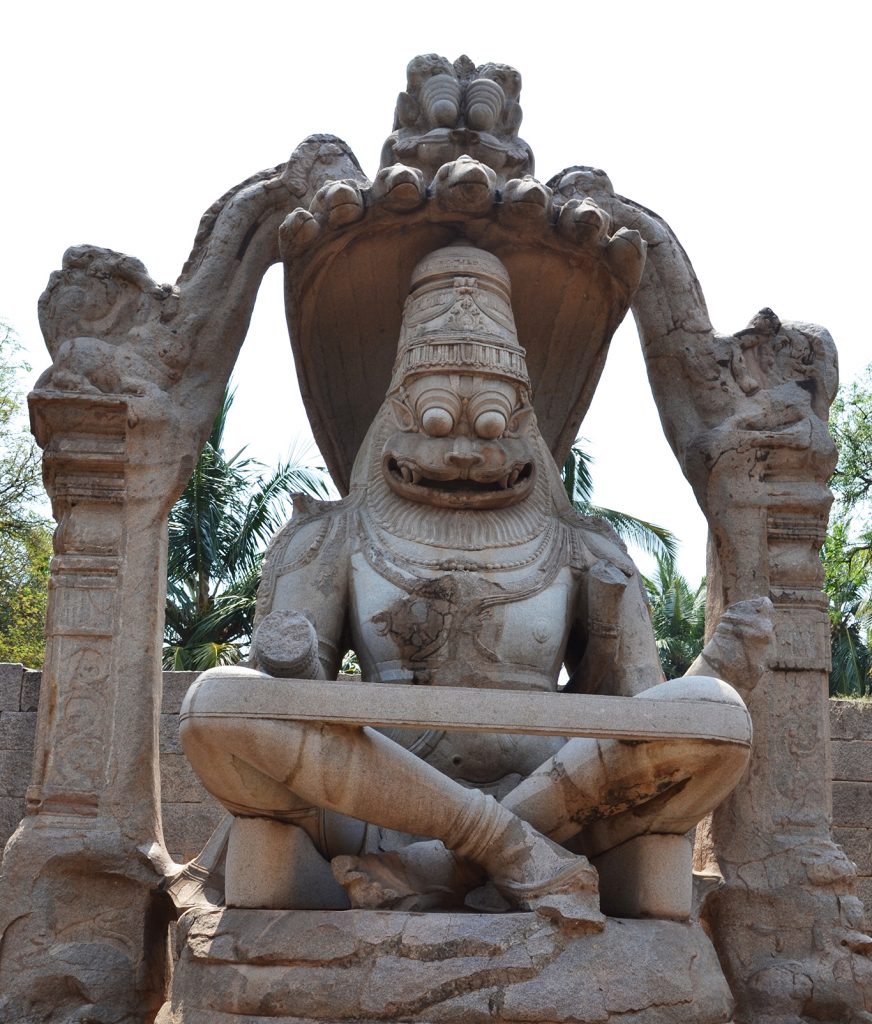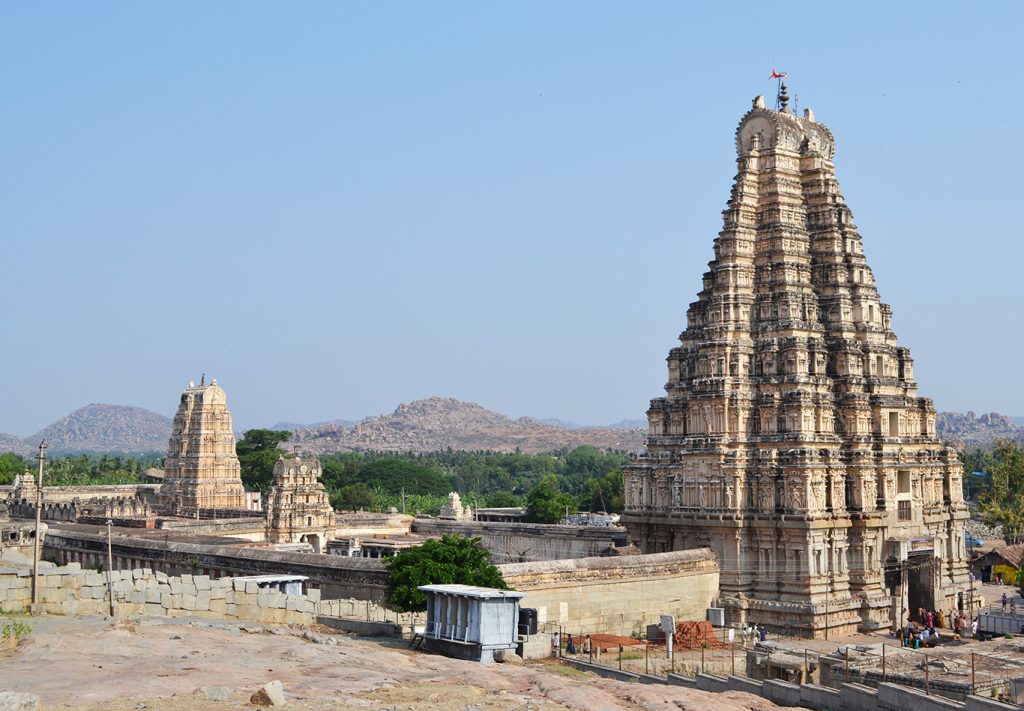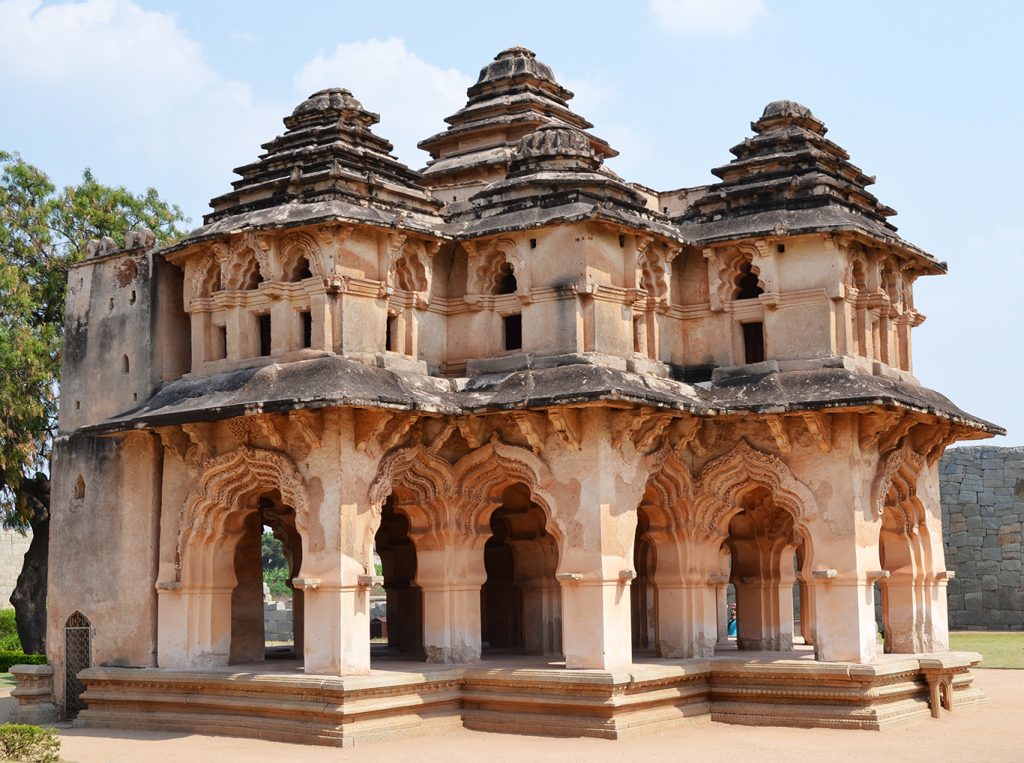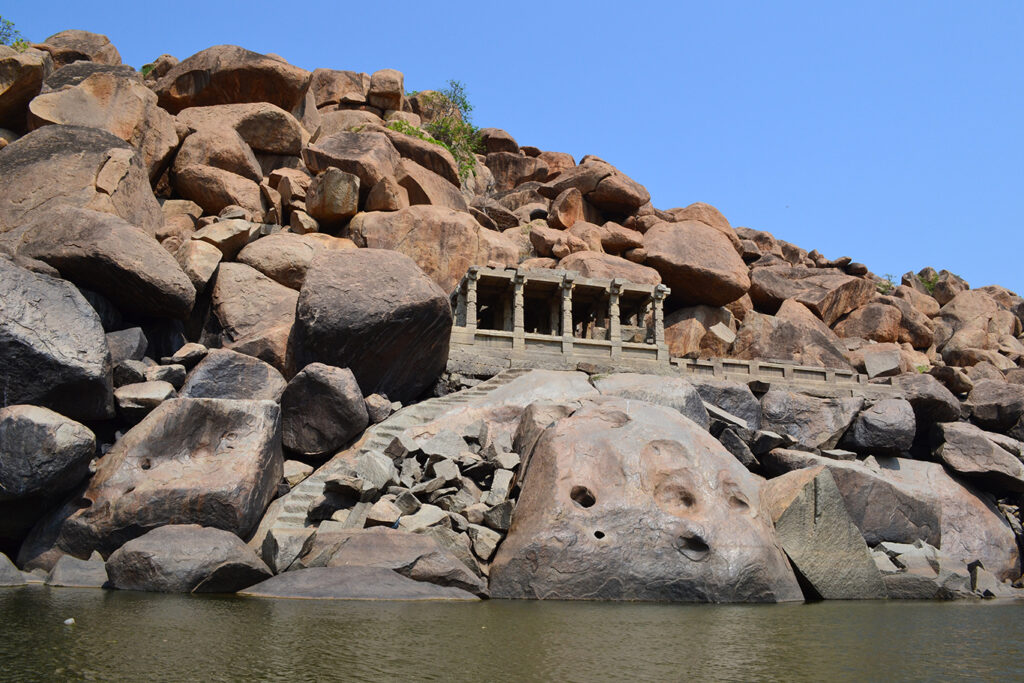As a tourist I first visited Hampi, a few years back. I saw the Vittala Temple, checked out its musical pillars that were supposed to replicate notes of musical scale, visited the tourist attraction Virupaksha Temple, then the Hemakuta group of temples and the Royal Centre, consisting of the Lotus Mahal, Mahanavami Dibba, Hazara Rama Temple, etc. ‘This is Hampi in a nutshell’ touted our Hampi guide. Seeing the bazaar layout, the temples, I did realise that like the ancient civilisations, Hampi too had a royal citadel where the noble and powerful lived- kings, queens, commanders, military men, etc., and an urban centre, where the commoners resided. This was my take when I first saw this World Heritage Site.
The story of Pampa
Years later, when I researched about the Vijayanagara dynasty, I realised the importance of this site and the numerous stories that abound in each of its structures. Take the case of Virupaksha Temple. It is one of the ancient temples of this region and perhaps can be dated to 9th/10th century. It is dedicated to the deity Virupaksha – the God with oblique eyes, and he is accompanied by consorts Pampa and Bhuvaneshwari. Incidentally, if you do not know who Pampa is, here is a brief story. Pampa is regarded as Goddess Tungabhadra. She was the daughter of Brahma who wished Shiva to be her life partner. After sever- al years of penance at Hemakuta Hill, Shiva appeared before her in the form of Virupaksha and married her. It is said that gold was showered on the nearby Hemakuta Hill by the gods. That is why the name Hemakuta – heap of gold. Every year, in remembrance of their bond, a celestial marriage between Virupaksha and Pampa happens during the temple’s Brahmostva festival.
Hemakuta Hill temples
At the Hemakuta Hill adjacent to Virupaksha Temple, there are a cluster of temples. At first sight you will only see granite towers, a couple of shivlingas and mantapas. But here is the interesting part. One of the structures with three shivlingas was installed by a ruler of Kampili. And he was no ordinary ruler. Harihara and Bukka — the founders of Vijayanagara dynasty, used to work under him, and this king, who rebelled against the Muslim sultans would have been their initial source of inspiration. Another temple to look out for is the Ramalingeshwara Temple that was said to be the retreat of Vidyaranya – guru, advisor, and supporter of Harihara and Bukka. Apart from this, there are two huge monoliths of Ganesha that are worth checking out.
The idols are named after grains; one is the mustard seed or Sasivekalu Ganesha, which is 2.4m high, and the other is Kadlekalu or gram lentil Ganesha, which is 4.5 m high. Here is a brief story of how Vijayanagara, or the ‘City of Victory’ came into being.
The rise of Vijayanagara
During the turn of the 14th century, the South was facing the onslaught of Muslim Sultans from Delhi. North Deccan was ruled by Yadavas of Devagiri, Kakatiya dynasty ruled from Warangal, Hoysalas from Dwarasamudra, and Pandyas from Madurai till down south. Invasions by Allauddin, Mallikafar and Mohammed bin Tughlaq, the loot and plunder policy of the Sultans had weakened these powerful dynasties of the South. There was not a single major power in the South to resist these onslaughts. However some principalities did offer resistance. One of them was a minor kingdom called Kampili. The ruler courageously resisted the armies. However, they were defeated by forces of Mohammed bin Tughlaq. The ruler Kampilideva died fighting, and the royal women committed suicide. People were taken prisoners and among them were Harihara and Bukka- treasury officers of the king. It is said that they were convert- ed to Muslims and sent back to Kampili as new governors.
However, an encounter with sage Vidyaranya – a saint of the Sringeri Mutt gave them a new direction. He urged them to establish a new kingdom that could protect the culture and heritage of South India. The brothers gave up Islam and Harihara laid the foundations of Vijayanagara dynasty on the banks of Tungabhadra, and he was crowned king in 1336 AD. However, not all agree to this version of story. There is an Andhra version that claims that these brothers were from Warangal, who later went to Kampili.
There is a Kannada version also that says that they were from Karnataka and were working under Hoysala King Ballal-III. To resist the Muslim onslaughts, the Hoysala King built a new city – Vijaya Virupaksha on the banks of Tung- abhadra and made Harihara and Bukka its protectors. After the death of the king, his son – Vijaya Virupaksha – was a weak ruler. So these brothers apparently took control.
The Krishna Temple
The Krishna Temple adjacent to Hemakuta Hill has no idol. At first glance and without a proper guide, you will neglect it as another ruin. But it is a proof of Krishnadevaraya’s heroics, who ruled in the time period 1509-1529.
When he came to power, he had a lot of challenges. The Gajapatis from Orissa, and the Kakatiyas from Warangal had occupied Vijayanagara territories. For the first two decades he had to fight and reclaim these territories. The temple was consecrated in 1513 after his victory over the Gajapati kings from Orissa. The idol was Balagopala or baby Krishna brought from Udayagiri Fort that Krishnadevaraya captured during his battle with Orissa Gajapatis. There are inscrip- tions in the temple that record the military achievements of the king. The granite idol of Balakrishna is now in the Chen- nai museum.
Krishnadevaraya was a worshipper of Vishnu and he built new temples, added towers and mantapas. At Virupaksha Temple, some of the towers and mantapa are his contributions.
The story of Tuka
When Krishnadevaraya captured Udayagiri, he took prisoners. One of them was the Queen of Gajapati and she was sent to Vijayanagara. The King of Gajapati had to give his daughter Tuka in marriage to Krishandevaraya in return for his wife. However ,Tuka was not pleased with this. And it is said that she tried to poison Krishandevaraya. However, the king was saved and Tuka was banished from the kingdom. Years later it is said that she repented and composed verses, and finally she returned to Krishnadevaraya.
Another worthy structure to check out is the monolith of Narasimha. It is a 6.7m tall statue sitting cross-legged, with a seven-headed snake behind him. A statue of goddess Lakshmi sits on his left thigh, but it is now in a damaged condition. An inscription mentions that this statue was carved by a Brahmin Krishna Bhatta in 1528. Nearby is a three meter tall monolithic linga on a pedestal.

Vittala Temple
This is a beautiful temple built in the reign of Deva Raya II (1424-1446). It has three gopuras or towers. The east and north tower were commissioned by the two queens of Krishnadevaraya in 1513. The Maha Mantapa was built to commemorate Krishnadevaraya’s victory. Worship used to happen here until the fall of Vijayanagars. The battle of Talikota that proved decisive to Vijayanagara dynasty took place in 1565 AD and the dynasty though it ruled for another 100 years never truly recovered after this battle.
A stone chariot with four wheels faces the east gopuram. It is dedicated to Garuda – Vishnu’s vehicle. It looks monolithic, but isn’t. It is in fact made from many stone blocks. Nearby the temple vicinity is a king’s balance. The king was weighed here in gems and grains on special occasions, and these were then distributed to the common people. The Sugriva Cave and Narasimha Temple are other attractions nearby.
All these temple complexes – the Virupaksha Temple, the Krishna and the Vittala Temple form the sacred center of Hampi. There is one other temple belonging to this group. The Achyutaraya Temple dedicated to Lord Tiruvengalanatha at the foot of Matanga Hill. It was constructed by the half-brother of Achyutaraya Hiriya Tirumala Raja in 1534. The temple is dedicated to Vishnu and has a shrine for Lakshmi. The temple is located east of Virupaksha Temple. Other attractions nearby are chakratirtha that is a sacred bathing ghat, and the Kodandarama Temple with huge relics of Rama, Sita, Lakshmana and Hanuman.
All the major temples – Virupaksha, Vittala, Achyutaraya, and Krishna, had bazaar roads. Most of them are in ruins now. The Hampi bazaar was an important bazaar — 717 meters long, it had shops on both sides. Gold, silk, precious stones, spices, etc., were sold here. While the Arabs came here selling velvets, the Chinese sold silk, the Romans wine, and took back aromatic spices.

Apart from the temples there are a group of monu- ments that fall under the Royal Center. In 1443, an ambassador who visited Hampi described it as a fortified city with seven concentric layers of walls with gateways and watch- towers. Apart from the sacred centre, there was the Royal Center that was an oval shaped layout with temples, stables, watch towers, baths, gateways aqueducts, etc., forming part of its space. The city also had a third zone. This constituted the rest of the urban city and enclosed towns and villages like Anegundi, Kampili, and Hospete.
The Royal Center monuments
At the heart of the Royal Center was the Hazara Rama Temple. The temple is said to have been constructed during the reign of Devaraya I and was the chapel meant for the royals. Palaces, platforms, stables surrounded this structure. The Hazara Rama Temple has 108 Ramayana scenes depicted in its panels. Hampi was after all considered the Kishkinda region of Ramayana. And there are a lot of scenes from Ramayana that took place here. Here is a brief summary.

Anecdotes from Ramayana
Kishkinda was the kingdom of monkeys and was ruled by Vali. Vali had a younger brother Sugriva who for no fault of his was ostracised from the kingdom for betraying Vali. Sugriva took shelter at Matanga Hill of Hampi with his friend and supporter Hanuman. Rama and Lakshmana while searching for Sita meet Hanuman at Hampi, who takes them to Sugriva. Rama agrees to kill Vali and make Sugriva king. In return, he wants Sugriva’s help in rescuing Sita. In keeping with his promise, Rama kills Vali and crowns Sugriva king. Hanuman then goes in search of Sita while Rama waits for his return.
All these associations can be seen at Hampi. The Kodandarama Temple is the place where Sugriva was crowned king. When Sita was kidnapped by the Lanka King Ravana, she dropped her jewels while flying. This was kept safely by Hanuman in the cave at Hampi behind Vittala Temple. The Malyavanta Hill was where Rama and Lakshmana waited for Hanuman’s return. Today it has a Raghunatha Temple. And you can see a number of relics of Rama, Lakshmana and Hanuman on the rocks, temples and ruins at Hampi. The Hazara Rama Temple depicts a number of such Ramayana scenes. Another surprising factor is that the temple is axially aligned with Matanga and Malyavanta Hill. Near the temple is the Mahanavami Dibba.
Mahanavami Dibba
The Mahanavami Dibba was the stage meant for royal display. It was a multi-storied platform eight metre high, with each stage being added at different time periods. The lower two stages were added in 14th century. It is said that this platform was used by the kings for important festivals like Dasara celebrations, which was one of the major events celebrated in the kingdom. Generals were awarded during this day, tributes were paid to the king by noblemen – there were exhibits of power – soldiers, horses, and elephants used to be displayed. Foreign envoys came visiting. Wrestling matches were held – prizes were award- ed. Dance and music played a huge role in these celebrations. All these details are carved in every inch of granite in the Mahanavami platform. Elephants, horses led by Arabs, soldiers with weapons, headgear, and people beating drums and playing instruments – all these are depicted beautifully.
Zenana quarters and other structures
Zenana quarters was supposed to be a place reserved for royal women, but it does not seem to be true. The presence of a parade ground and stables nearby these quarters signifies that the royal women of Vijayanagara could not have lived here. The quarters however is a walled area with three watch towers. It has various structures like a treasury office, Jal Mahal, Queen’s Residence and Lotus Mahal. The Lotus Mahal is a square shaped plan with symmetrical projections on every side. It is a double storied hybrid structure in Indo-Islamic style.

Close to the the Zenana area you come across elephants stables. There are rows of 11 chambers here, each having space for two elephants. The rooms have arched doors and are topped with domes of pyramidal, octagonal or circular shapes.
Apart from these, there are other structures like the Queen’s Bath and temples nearby.
The Queen’s Bath located south-east of royal centre has an arched doorway, a square pool 1.8 meters deep, surrounded by ornate balconies with arched windows.
A water channel runs around the bath. Once again Queen’s Bath could not have been reserved for women. Most likely it was for men and their companions. Near to the Queen’s Bath is the Chandrashekara Temple.
There is also an underground Virupaksha Temple here. It seems to be a 14th century structure and was perhaps used by the royal family.
Other attractions of Hampi
There are more than 1,000 ruins in Hampi. Significant among them are gateways. One of them is Talarighat gateway – a toll collection point near the Vittala Temple complex. It is a two-storied structure built into the city’s fortification wall. Another is the Bhima gateway. Other important monuments are the Saraswati Temple, the octagonal bath, Jain monuments like Ganagitti Temple dedicated to Kunthunatha Tirthankara, and Islamic structures like mosques and tombs. Also check out the archeological museum at Kamalapura that exhibits bronze sculptures, pre-historic and proto historic antiquities.
A coracle ride
A coracle ride in Tungabhadra River. though not allowed in some months, is a must-do activity while you are at Hampi. Not only does it give you a peek into the granite landscape ,it gives you splendid views of weathered rock formations on either side of the river. There are also some ruins on the banks of the river – KotiLinga, Sun Temple, and dilapidated mantapas etc., that are partially submerged during the monsoon months. The Purandara mantapa with the idol of Purandaradasa, father of Carnatic music, and Vijaya Vittala mantapa are other attractions that you can visit during the ride.

Anegundi
You can also check out Anegundi that was a fortified town even before the advent of the Vijayanagaras. It has a small Ranganatha Temple, a Jain temple and also has the Anjanadri Hill that is supposed to be the birth place of Hanuman. Pampa-sarovar dedicated to goddess Pampa is also nearby. Nava Brindavana, the brindavan of nine Madhwa saints, is also located here. It is a pilgrimage spot for Madhva Brahmins, the followers of saint Madhwacharya, and is reached via a ferry from Anegundi.


 [/column]
[/column]